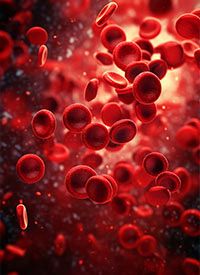News
Article
RGI-2001 Plus Tacrolimus/Methotrexate Demonstrates Protective Effect From Acute GVHD Post Allo-HSCT
Author(s):
Prophylactic treatment with RGI-2001 plus tacrolimus and methotrexate led to a lower incidence of acute GVHD vs CIBMTR control following allo-HSCT.
Red blood cell | - stock.adobe.com

Prophylactic treatment with RGI-2001, a natural killer (NK) T-cell activator, in combination with tacrolimus and methotrexate led to a significant reduction in the incidence of grade II to IV acute graft-vs-host disease (aGVHD) compared with the CIBMTR control in patients with hematologic malignancies who underwent allogeneic hematopoietic cell transplant (allo-HSCT), according to findings from the phase 2b RGI-2001-301 trial (NCT04014790) presented during the 2024 AACR Annual Meeting.1
The 1-year overall survival (OS) rate was 91.7% with RGI-2001 (n = 40) vs 79.2% with CIBMTR (n = 160; OR, 3.08; 95% CI, 1.03-9.17; P =.04). The 1-year relapse-free survival rates were 12.5% (n = 38) vs 15.9%, respectively (n = 142; OR, 1.31; 95% CI, 0.51-3.34; P =.57). The rates of grade II to IV aGVHD-free survival at day 180 were 72.9% (n = 36) and 50.7% (n = 103; OR, 2.78; 95% CI, 1.37-5.66; P =.005). The rates of grade III to IV aGVHD-free survival at day 180 were 91.7% (n = 44) and 77.3% (n = 157; OR, 3.36; 95% CI, 1.13-9.94; P =.03).
“Patients treated with RGI-2001 and tacrolimus/methotrexate had significantly lower rates of grade II to IV aGVHD 100 and 180 days post-alloHSCT compared with CIBMTR control. OS is significantly increased while relapse is not changed for patients receiving RGI-2001,” Calvin K. Lee, MS, scientist at Pfizer, and coauthors wrote in the poster.
aGVHD is associated with significant morbidity and mortality, resulting from donor-derived T-cell attacks on an immunosuppressed environment. NK T cells and T-regulatory cells (Tregs) are critical in the prevention of aGVHD.
RGI-2001 is a liposomal formulation of the CD1d ligand a-GalCer that can activate NK T cells and Tregs. In a previous phase 2a trial, a single dose of RGI-2001 100 µg/kg led to increased Treg counts, which was associated with a lower incidence of aGVHD.
Additionally, RGI-2001 was previously evaluated with tacrolimus/methotrexate as prophylaxis for aGVHD in the phase 2b RGI-2001-003 study (NCT04014790) in patients undergoing allo-HSCT. Patient blood samples were evaluated for expansion of NK T cells, Tregs, and other immune cell subsets. The results revealed a lower incidence of aGVHD in patients who received RGI-2001 vs the control. Moreover, higher levels of NK T cells and Tregs were found in patients who received RGI-2001 and did not develop aGVHD.2
In this phase 2b study, investigators further evaluated the prophylactic potential of the agent through repeat dosing.1
Regarding baseline characteristics in the RGI-2001 arm, the median age was 52 years (range, 21-65). Most patients were White (92%), male (56%), and had acute myeloid leukemia (AML; 54%), acute lymphoblastic leukemia (ALL; 23%), or myelodysplastic syndrome (MDS; 15%). The most common donor type and graft source was 8/8 unrelated (67%) and PBSC (81%), respectively. The majority of patients received fludarabine and busulfan conditioning (83%) and all had received calcineurin inhibitors (CNIs) plus methotrexate for GVHD prophylaxis.
In the CIBMTR cohort, the median age was 50 years (range, 18-66). Most patients were White (86%), male (54%), and had AML (52%), ALL (27%), or MDS (14%). The most common donor type and graft source was 8/8 unrelated (61%) and PBSC (83%), respectively. The majority of patients received fludarabine and busulfan conditioning (69%) and 99.5% had received CNI plus methotrexate for GVHD prophylaxis.
The incidence of aGVHD was also consistently lower with RGI-2001 (n = 48) compared with CIBMTR (n = 207) at different time points. The rates of II to IV aGVHD at day 100 were 22.9% with RGI-2001 vs 38.8% with CIBMTR (OR, 2.29; 95% CI, 1.08-4.85; P =.030). At day 180 these rates were 22.9% vs 42.8%, respectively (OR, 2.68; 95% CI, 1.27-5.65; P =.010). The rates of grade III to IV aGVHD at day 100 were 4.2% vs 12.4%, respectively (OR, 3.25; 95% CI, 0.74-14.36; P =.119). At day 180 these rates were 4.2% vs 13.9%, respectively (OR, 3.65; 95% CI, 0.83-16.04; P =.086). However, the 1-year rate of moderate to severe chronic GVHD was 33.3% in both arms (OR, 1.02; 95% CI, 0.52-1.98; P =.961).
Additional results demonstrated evidence of peripheral NK T-cell expansion at day 28 in patients who derived clinical benefit from RGI-2001. Notably, the mean levels of absolute Tregs at day 42, 1 week after the last dose of RGI-2001, were higher in patients who were alive and had not developed grade II to IV aGVHD by day 180 vs those who had died and/or developed aGVHD.
The authors also noted that a substantial proportion of activated Tregs were proliferating, and to a higher degree compared with nonactivated Tregs. The proliferation occurred to a greater extent after treatment compared with baseline samples, which was consistent with results from the phase 1/2a RGI-2001-002 trial (NCT01379209).
“[This study] provides further evidence regarding RGI-2001’s impact on aGVHD, Treg activation and NK T-cell populations,” study authors concluded.
References
- Lee CK, Caron C, Strukel S, et al. Phase 2b study of alloHSCT patients receiving RGI-2001, an NKT cell activator, demonstrates protection from acute GVHD, correlating with increased NKT and Treg cell number in patient blood. Presented at the 2024 AACR Annual Meeting; April 5-10, 2024; San Diego, CA. Abstract CT242.
- Chen YB, Saad A, Farhan SY, et al. RGI-2001 infusion for prevention of acute Gvhd after allogeneic hematopoietic cell transplantation. Blood. 2022;140(suppl 1):1877-1878. doi:10.1182/blood-2022-162512








